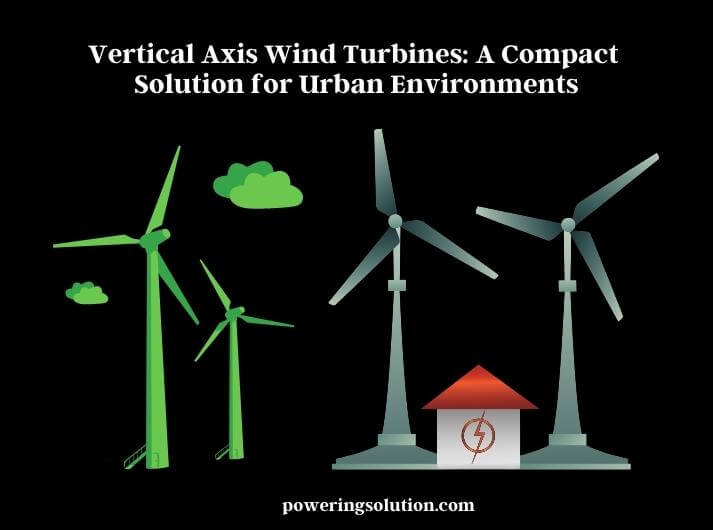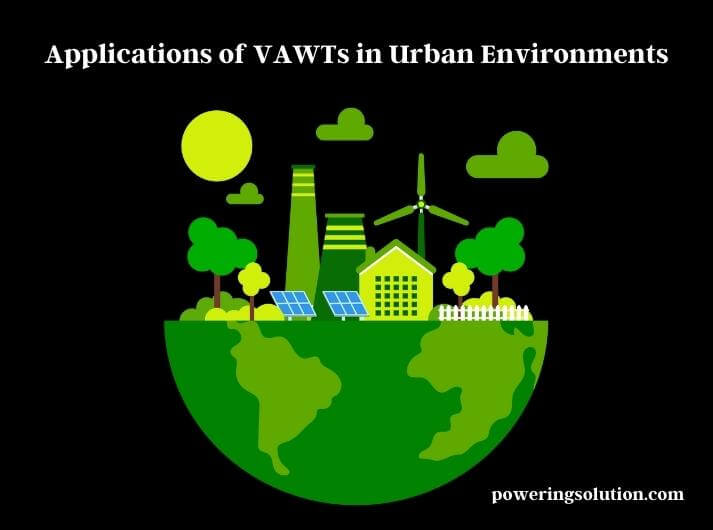Cities around the world are experiencing unprecedented growth, and this trend is expected to continue in the coming years. This rapid urbanization has resulted in a surge in energy demand, putting a strain on existing energy infrastructures and contributing to climate change. As a result, there is a growing need for sustainable energy solutions that can meet the energy demands of urban areas while reducing carbon emissions and promoting a greener future.

Wind energy is one of the most promising renewable energy sources for urban areas. Traditional horizontal axis wind turbines (HAWTs) are often not feasible due to their large size, high noise levels, and need for wind direction alignment. Vertical axis wind turbines (VAWTs), on the other hand, offer a compact and efficient solution for urban environments. They can be installed on rooftops and other urban locations without disturbing the surrounding landscape or causing noise pollution.
How VAWTs Work?
Vertical axis wind turbines (VAWTs) operate on the same basic principle as traditional horizontal axis wind turbines (HAWTs) but with a few key differences. While HAWTs have blades that rotate around a horizontal axis, VAWTs have blades that rotate around a vertical axis, which makes them ideal for use in urban areas where wind direction is variable and unpredictable.
VAWTs are composed of two main parts: the rotor and the generator. The rotor consists of two or more airfoil blades that are attached to a central shaft. When the wind blows against the blades, they rotate around the central shaft, which in turn spins the generator, producing electricity.
Unlike HAWTs, which require a constant wind speed and direction to operate efficiently, VAWTs can operate in any wind direction, including low-speed and turbulent winds. This makes them well-suited for use in urban environments, where wind direction and speed can be variable due to buildings and other obstacles.
VAWTs are also compact and can be installed on rooftops, balconies, or other urban locations without taking up much space. They can even be integrated into buildings, reducing the need for external structures and minimizing their impact on the surrounding landscape. Additionally, because they are located closer to the ground, VAWTs are less visible and create less noise pollution compared to HAWTs.
VAWTs offer a compact and efficient solution for urban areas looking to generate renewable energy in a sustainable and environmentally friendly way.
Benefits of VAWTs
- Small Footprint
One of the primary advantages of VAWTs is their small footprint. Unlike traditional wind turbines, which require a large area to be installed and operated, VAWTs can be installed on rooftops, balconies, or other small spaces. This makes them an ideal solution for urban environments where space is limited.
- Low Wind Speed
Traditional wind turbines require a minimum wind speed of around 12 mph to generate electricity. VAWTs, on the other hand, can operate at low wind speeds of 5-6 mph. This means they can generate electricity even in urban areas where wind speeds are typically lower.
- Noisy Operation
Traditional wind turbines can be noisy and cause disturbance to nearby residents. VAWTs, however, operate quietly and do not produce any noise pollution. This makes them an ideal solution for urban areas where noise pollution is a concern.
- Low Maintenance
Traditional wind turbines require regular maintenance to keep them running efficiently. VAWTs, on the other hand, have a simple design and require minimal maintenance. This makes them a cost-effective solution for urban areas where maintenance costs can be high.
- Aesthetically Pleasing
VAWTs have a unique design that can be visually appealing. This makes them a desirable addition to urban environments where aesthetics are important.
Applications of VAWTs in Urban Environments
Vertical axis wind turbines (VAWTs) have several applications in urban environments, where they offer a compact and efficient solution for generating renewable energy. Here are some of the main applications of VAWTs in urban areas:

Rooftop installations: VAWTs can be installed on rooftops of buildings in urban areas, making use of the often-neglected vertical space. This not only provides a source of renewable energy for the building but also reduces the building’s dependence on the grid, thus lowering energy costs.
Streetlights: VAWTs can be installed on streetlights, providing renewable energy to power the lights. This not only reduces energy costs but also provides a reliable source of power during power outages, improving safety in urban areas.
Residential areas: VAWTs can be installed in residential areas, providing a source of renewable energy for homes. This can help reduce energy costs for residents and promote energy independence.
Public spaces: VAWTs can be installed in public spaces such as parks and plazas, providing a source of renewable energy for public use. This can help reduce energy costs for the local government and promote the use of renewable energy.
Hybrid systems: VAWTs can be used in hybrid systems with solar panels, providing a more consistent source of renewable energy. This is particularly useful in urban areas where space is limited and solar panels may not be able to generate enough energy on their own.
Comparison of VAWTs with Traditional Wind Turbines
Vertical axis wind turbines (VAWTs) and traditional horizontal axis wind turbines (HAWTs) both generate electricity from wind, but there are some key differences between the two technologies.
- Efficiency: HAWTs are generally more efficient than VAWTs, as their blades can capture more wind energy per unit of swept area. This means that HAWTs can generate more electricity with a smaller rotor diameter compared to VAWTs.
- Size: VAWTs are generally more compact than HAWTs and can be installed in smaller areas, such as on rooftops or in urban spaces. HAWTs require larger open spaces and taller structures for installation.
- Wind direction: VAWTs can capture wind energy from any direction, whereas HAWTs need to be pointed in the direction of the wind for optimal performance. This makes VAWTs more suitable for urban environments where wind direction is variable and unpredictable.
- Noise: VAWTs produce less noise compared to HAWTs, as their blades rotate at lower speeds and are closer to the ground. This makes VAWTs more suitable for installation in urban areas where noise pollution is a concern.
- Maintenance: VAWTs are generally easier to maintain than HAWTs, as their components are located closer to the ground and can be accessed more easily. HAWTs require more complex maintenance procedures, such as gearbox replacements and blade inspections, which can be costly and time-consuming.
VAWTs offer a compact and efficient solution for generating renewable energy in urban environments, where space is limited and wind direction is variable. While HAWTs are generally more efficient, they require larger open spaces and are less suitable for installation in urban areas. Both technologies have their own advantages and drawbacks, and the choice between them depends on the specific needs and constraints of the installation site.
Challenges Faced by VAWTs
While vertical-axis wind turbines (VAWTs) offer many advantages for generating renewable energy in urban environments, there are also some challenges that need to be addressed in order to maximize their efficiency and effectiveness.
VAWTs require a certain minimum wind speed to generate electricity, typically around 4-5 meters per second. In urban environments, wind speeds are often lower due to the presence of buildings and other obstacles, which can limit the amount of energy that VAWTs can generate.
Wind turbulence caused by buildings and other structures can also affect the performance of VAWTs. Turbulent winds can cause the rotor blades to stall or vibrate, reducing their efficiency and increasing maintenance requirements.
VAWTs can be seen as less aesthetically pleasing compared to traditional horizontal axis wind turbines or other types of renewable energy technologies. This can make it difficult to gain public acceptance for VAWT installations in urban areas.
The initial cost of VAWT installations can be higher compared to other renewable energy technologies, which can make them less economically feasible in some situations.
VAWTs need to be designed and constructed to withstand the stresses of urban environments, including high winds, debris, and other environmental factors. This can require additional engineering and construction costs.
Despite these challenges, VAWTs offer a promising solution for generating renewable energy in urban environments. By addressing these challenges through improved design, engineering, and installation practices, VAWTs can help promote a sustainable and energy-efficient future.
Future of VAWTs
The future of vertical axis wind turbines (VAWTs) looks promising, as these innovative devices continue to gain popularity as a compact and efficient solution for generating renewable energy in urban environments. Here are some of the key trends and developments that are shaping the future of VAWTs:
- Improved design: VAWTs are being designed with more advanced materials and technologies that can increase their efficiency and durability. For example, some VAWTs are being designed with carbon fiber rotor blades that are stronger and lighter than traditional materials.
- Integration with other technologies: VAWTs are being integrated with other renewable energy technologies, such as solar panels and energy storage systems, to create hybrid energy systems that can provide more reliable and efficient power.
- Smart grid integration: VAWTs are being connected to smart grids that can optimize their performance based on real-time weather and energy demand data. This can help increase their efficiency and reduce their environmental impact.
- Cost reduction: As VAWT technology continues to mature, the cost of manufacturing and installation is expected to decrease, making it a more economically feasible solution for generating renewable energy in urban environments.
- Public acceptance: As awareness of climate change and the importance of renewable energy grows, VAWTs are likely to gain more public acceptance, especially as they become more aesthetically pleasing and integrated into the urban landscape.
The future of VAWTs looks bright, as these innovative devices continue to offer a compact and efficient solution for generating renewable energy in urban environments. As technology continues to evolve and mature, we can expect to see more widespread adoption of VAWTs in cities and other urban areas around the world.
Are you looking for a convenient and effective way to get in shape without having to go to the gym? If so, then Power Tower Systems may be the perfect solution for you. Read the article for details.
Last Assumption
Vertical-axis wind turbines (VAWTs) offer a compact and efficient solution for generating renewable energy in urban environments. They are an ideal technology for cities and other urban areas where space is limited, and wind conditions are often lower and more turbulent. VAWTs have several advantages over traditional wind turbines, including their compact size, lower noise levels, and improved safety. They are also becoming more aesthetically pleasing and easier to integrate into the urban landscape.
While VAWTs face several challenges, including low wind speeds, turbulence, and higher costs, these challenges are being addressed through improved design, engineering, and installation practices. As the technology continues to mature, VAWTs are likely to become a more economically feasible solution for generating renewable energy in urban environments.
VAWTs offer a promising solution for promoting a sustainable and energy-efficient future. By providing a clean, reliable, and renewable source of energy, VAWTs can help reduce greenhouse gas emissions and combat climate change. As awareness of the importance of renewable energy grows, we can expect to see more widespread adoption of VAWTs in cities and other urban areas around the world.
